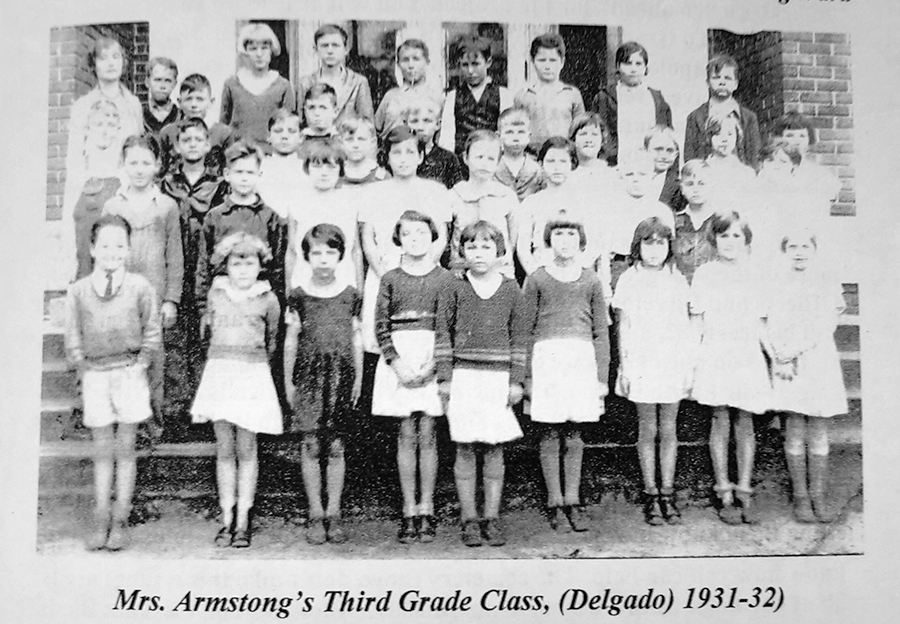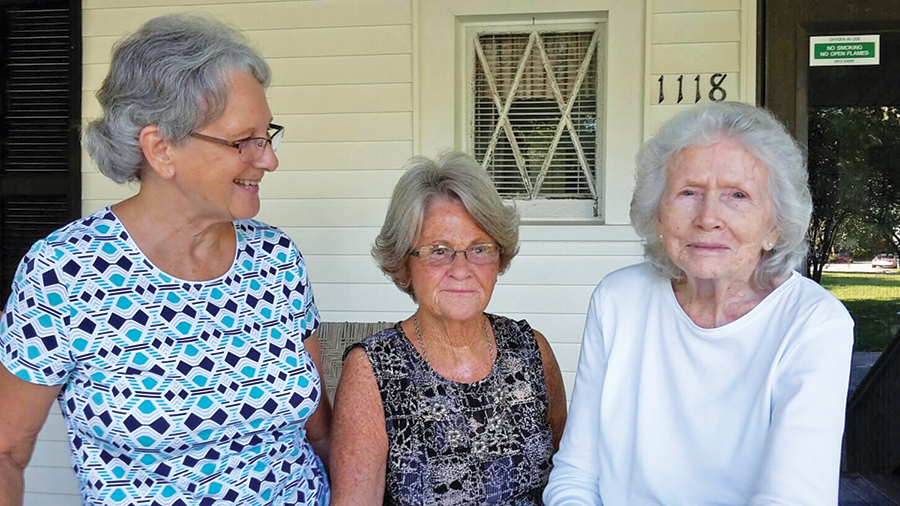The Spofford Mill is long gone, but the beloved working-class community it created has genuine staying power — and one proud heart
By Mark Holmberg
Woven into the fabric of central Wilmington is an uncanny story of a “city within a city,” a mini-town so deliberately self-contained, children growing up there rarely left its embrace. And if they dared to stray onto the bordering wealthy estates, “they’d holler for us to get onto the other side,” said 88-year-old Joyce Sawyer Barefoot, who was born in this sturdy mill village that lingers today.
She was among the legions of young “cottontails” and “lintheads” — as town people called them — who grew up in the 170 or so tiny cottages built around the vast Delgado/Spofford cotton mill that began completely transforming this part of town 116 years ago.
“We thought we were rich then,” Barefoot recalled. “We had a wonderful, wonderful childhood.” Yes, they were aware most of the rest of town considered them lower-class mill kids, but they didn’t care.
“We were proud of ourselves — but no one else was,” said 67-year-old Barbara Brock Pigford, who also grew up in the mill village and continues to live there today. Their memories of childhood and these tough little homes are as good and durable as the clean, white broadcloth churned out by the mile each day in the mill.
Since this is sort of a John Steinbeck novel in reverse, let’s begin with a Wilmington newspaper’s idyllic description as the 1900s began and the mill’s first whistle blast echoed across town:
“This time last January the ‘Mineral Spring’ two miles from the city, on the shell road, was a lonely but pretty spot in the midst of a young long leaf pine forest. The wind sighed ceaselessly through the pine tops and little did the people of Wilmington dream that the scene would soon shift.”

Cotton was king in this key Southern city (think of the Cotton Exchange and the Sprunt fortunes). Why not mill it here as other Southern cities were doing? By Thanksgiving 1899, nearly 100 engineers and machinists were installing milling equipment of the vast Delgado Cotton Mills Co. that would churn some 6 million yards of broadcloth each year (that’s roughly 9 miles a day) for the next 67 years.
In 1900, a $650 frame elementary school for 71 students was built at the mill, replaced in 1914 by the larger brick school on Colwell Avenue that stands today.
The mill also quickly built more than 100 tiny but solidly built frame cottages with cedar shake roofs in a carefully planned, oval-shaped plot now containing Dexter, Kent and Fowler streets, and Wrightsville and Delgado avenues. The early ones were pre-fabbed and shipped to the 100-acre site by rail. Later ones were stick-built on-site.
Twins Troy and Roy Hadley still live in one of the original houses at the corner of Dexter and Newton streets.
“Neither one of us married, so we just stayed here,” Troy, 72, said.
Their parents worked at the mill, as did the boys.
“They weren’t bad people to work for,” Troy said. “No qualms at all.” Except in the summer. “It was a hot job. That mill was hot!”
He picked quills, the spools of cotton thread that fed the hungry weaving machines, making $90 a week back in the late ’50s, as best as he can recall. But much earlier on, the mill paid low wages for long hours, roughly $20 a week for 60 hours. But by the 1930s, after it had changed hands, the Spofford Mill earned a reputation for benevolence, honoring wage-hour agreements even if it meant losses, according to a newspaper report at the time:
“No healthier or happier community can be found anywhere in this section,” the Wilmington Star newspaper reported in 1950.
The had their own spring-fed, Olympic-sized swimming pool with a diving board — believed to have been just the second pool in Wilmington at the time — as well as a doctor’s office with a full-time nurse, a visiting dentist, churches, garden plots, dances and holiday galas, sporting competitions and swarms of children growing up and playing together.
“We had a good life,” Barbara Pigford said as she and almost lifelong resident Sandra Stubbs gathered at Barefoot’s immaculately restored house on Spofford Circle. “We were healthy kids.”
“Absolutely marvelous,” said Sandra Stubbs, whose cottage across the street is clad in bricks from the mill’s smokestack when the factory was demolished in 1972, five years after it closed.
Nearly 100 years ago, the mill started adding cottages in another section across the shell road, including part of modern Wrightsville Avenue, Hill and Circle streets and Spofford Circle. It’s still known as New Mill Hill or just New Hill, as opposed to Old Hill across the way.
Imagine! The children had their own central, circular playground known as the “pea field” that remains today. (“That’s how you can tell if you’re a local,” Stubbs said, “if you call it the ‘pea field.’”)
Some of the kids would drain the pool every Friday and refill it on Monday. “It was freezing cold!” Pigford said as her longtime companions nodded.
The clanging trolley to Shell Island (Wrightsville Beach) rumbled right past their village. The Cape Fear Country Club, where some of the boys caddied, was on the other side. They would play in the little creek — “the dye ditch” — that still runs under Wrightsville Avenue. (Contrary to legend, it wasn’t colored with dye.)
“Everybody watched everybody’s children,” Stubbs said. “We were all family.”

Virtually every little bungalow was an open house to neighborhood children. Families shifted around to the slightly different-sized cottages as babies were born or kids grew up and moved on. “We moved from over there to over here, to there,” Pigford said, pointing around her beloved neighborhood that has changed surprisingly little.
The mill was the village’s protector and benefactor, its reason for existing. “When Hurricane Hazel came in 1954, everyone went into the basement of the mill,” Stubbs recalled. “We were playing on the bales” of cotton.
So you can imagine the shock to the village when the mill closed in 1967.
“It ruined everything around here,” Pigford said. “People around here in their 40s and 50s, that was all they had ever done their whole life.” Some found work at Timmie Corporation, another textile manufacturer in town. Others moved away to work at other cotton mills in North Carolina and beyond. “My dad moved us to Roanoke Rapids,” Barefoot said. (But of course she moved back.)
“I went into carpentry work when the mill closed down,” Troy Hadley said.
The mill was demolished in 1972 (the Creek Apartments were later built on the site) but its stately office still stands at 2231 Wrightsville Ave. The bungalows were sold mostly to the mill families for $2,000 to $3,400, depending on the size and location.
But time hasn’t treated Old Mill Hill and New Mill Hill equally.
“If you look around here you can see that,” Hadley said. He has watched more than a few of the Old Hill houses get torn down. Many others were bought up by a developer and are now rentals. And some commercial buildings moved into the village when it was rezoned.
But New Hill has jealously guarded its identity. It even successfully fought off being designated as a historic neighborhood because residents have a low tolerance for any kind of meddling. One of the 600-square-foot bungalows burned and was replaced with a big, modern house, and a few others had to be demolished recently. But for the most part, much of New Hill looks the same as it did and is largely privately owned. Even the old original boarding house still stands.
Many owners have added on to the back of their cottages. (Apparently, that was the plan when the mill laid out the narrow but deep lots.) Some, like Stubbs and Barefoot, have completely renovated so their homes look almost new inside and out. Others have worked with original structures to create delightfully artistic and cozy modern homes with vaulted ceilings and a mix of original woods and modern materials, lighting and appliances. The deluxe Hill Street kitchen and dining area of a retired pastry chef, Brad (he preferred his last name not to be published), could appear in any home or cooking magazine.

From left, Sandra Stubbs, Barbara Pigford, Joyce Barefoot
The bungalow of well-known artist Doug Campbell — you can see his work inside and out at Indochine — is as wild and distinctive as any home in Wilmington, with stone, wood, original paintings and metalwork mashed up artfully in the house and garden. When he moved his studio to Hill Street in 1992, “you could buy the whole block for $100,000. Mine was $18,000.”
It’s a sweet, somewhat isolated place between town and the beach filled with the kind of small houses that are increasingly trendy as kid-free boomers and millennials collide in the housing market. “There’s an assortment of people,” Campbell said. “Just an interesting place.”
Thus, you have young surf instructor Jonathan Sundberg renovating his first home two doors down from 65-year-old Marshall Martin, whose grandparents lived there and worked at the mill.
Yes, an old cotton mill is still what binds this neighborhood together.
The existing “cottontails” and “lintheads” still gather every fall to remember and celebrate a grand childhood in this most distinctive neighborhood woven into the fabric of Wilmington, this city within a city where, as Barbara Pigford said, “We had a good life.”
Mark Holmberg splits his time between Richmond, Virginia and the Port City, writing and roaming, believing there’s room for good ol’ printed words about believers and strays and adventurers.


